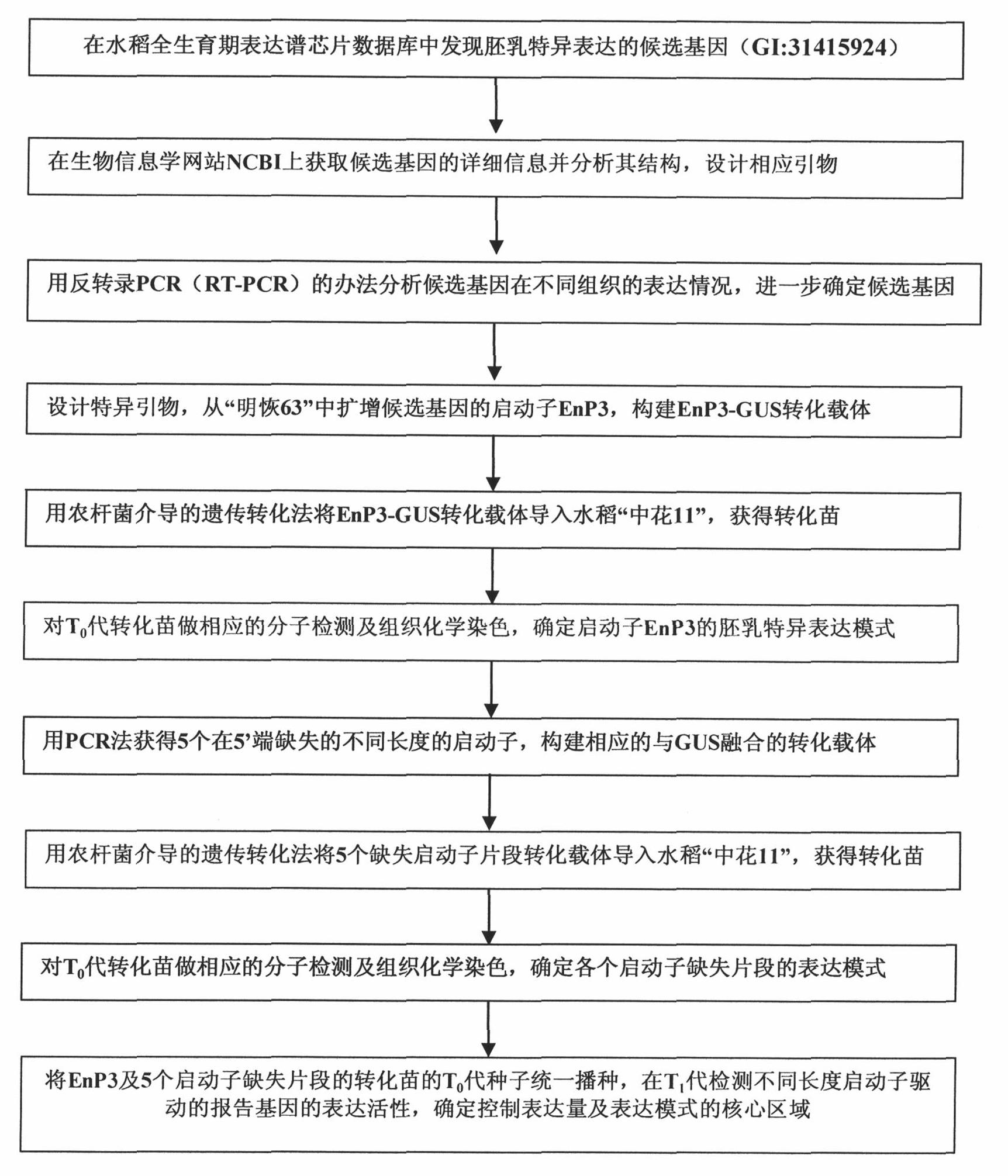Promoter and expression mode identification of rice endosperm specific expression gene
A promoter and rice technology, applied in the field of plant genetic engineering, can solve the problems of enhancing the expression intensity of the promoter and not being able to determine the specific expression characteristics of the endosperm of the promoter
- Summary
- Abstract
- Description
- Claims
- Application Information
AI Technical Summary
Problems solved by technology
Method used
Image
Examples
Embodiment 1
[0031] Example 1: Verification of the expression profile of the endosperm-specific expression candidate gene (Genebank accession number is GI: 31415924)
[0032] Material preparation: The material used in this example is the indica rice variety (Oryza sativa ssp.Indica) Minghui 63 (an excellent rice restorer line widely used in my country), and the planting method is hydroponics. The composition of the nutrient solution is as follows: 1.44mM NH 4 NO 3 , 0.3mM NaH 2 PO 4 , 0.5mM K 2 SO 4 , 1.0 mM CaCl 2 , 1.6mM MgSO 4 , 0.17mM NaSiO 3 , 50μm Fe-EDTA, 0.06μM (NH 4 ) 6 Mo 7 o 24 , 15 μM H 3 BO 3 , 8 μM nCl 2 , 0.12 μM CuSO 4 , 0.12 μM ZnSO 4 , 29 μM FeCl 3 , 40.5 μM Citric acid, pH 5.5 (Yoshida et al., 1976). Take leaves, leaf sheaths, stems, roots and ears at the booting stage, and take endosperm 14 days after fertilization. RNA was extracted using the Trizol Reagent (Invitrogen, Carisbad, CA, USA) method. The total RNA was detected by 1.4% agarose gel electr...
Embodiment 2
[0034] Example 2: Acquisition of endosperm-specific expression promoter EnP3 candidate fragments and corresponding deletion fragments (refer to "Molecular Cloning Experiment Guide (Second Edition)" (J. Sambrook et al., 1996) for routine operations in molecular biology
[0035] Extraction of Minghui 63 Genomic DNA: Take fresh leaves at the peak tillering stage of Minghui 63 to extract its genomic DNA. CTAB) extraction method (Murray and Thompson.1980), the extracted DNA was completely dissolved and stored in a -20°C refrigerator.
[0036] Extract the upstream sequence of the candidate gene GI: 31415924 on the bioinformatics website NCBI (http: / / www.ncbi.nlm.nih.gov / ), specifically -976 to +54 (transcription start point is +1) A total of 1130bp intervals were used as promoter candidate fragments. Name it EnP3. Using the PCR method, using the extracted Minghui 63 genomic DNA as a template, by designing specific primers (EnP3F: AAGCTT GGAGCATTTGTAGGAATGCC; EnP3R: GGATCC ...
Embodiment 3
[0040] Example 3: Construction of transformation vectors for endosperm-specific expression promoter EnP3 candidate fragments and corresponding deletion fragments (refer to J. Sambrook et al., "Molecular Cloning Experiment Guide (Second Edition)" for the corresponding molecular biology routine operations, Science Press (1996).
[0041] (1) Digest vector DX2181. The DX2181 vector was transformed on the basis of pCAMBIA1380 (the vector used by the Australian CAMBIA (Center for the Application of Molecular Biology to International Agriculture, CAMBIA) laboratory in the world for public communication), and at the multiple cloning site with the opposite Direction Constructed a GUS gene and EGFP gene respectively, the vector map and multiple cloning sites and other information can be found in image 3 . Digest DX2181 with HindIII and BamHI, recover the digested product with UNIQ-10 Column DNA Gel Recovery Kit (produced by Shanghai Sangon Bioengineering Technology Service Co., Ltd.)...
PUM
 Login to View More
Login to View More Abstract
Description
Claims
Application Information
 Login to View More
Login to View More - R&D
- Intellectual Property
- Life Sciences
- Materials
- Tech Scout
- Unparalleled Data Quality
- Higher Quality Content
- 60% Fewer Hallucinations
Browse by: Latest US Patents, China's latest patents, Technical Efficacy Thesaurus, Application Domain, Technology Topic, Popular Technical Reports.
© 2025 PatSnap. All rights reserved.Legal|Privacy policy|Modern Slavery Act Transparency Statement|Sitemap|About US| Contact US: help@patsnap.com



